child seat CHEVROLET MONTE CARLO 2003 6.G User Guide
[x] Cancel search | Manufacturer: CHEVROLET, Model Year: 2003, Model line: MONTE CARLO, Model: CHEVROLET MONTE CARLO 2003 6.GPages: 394, PDF Size: 2.73 MB
Page 43 of 394
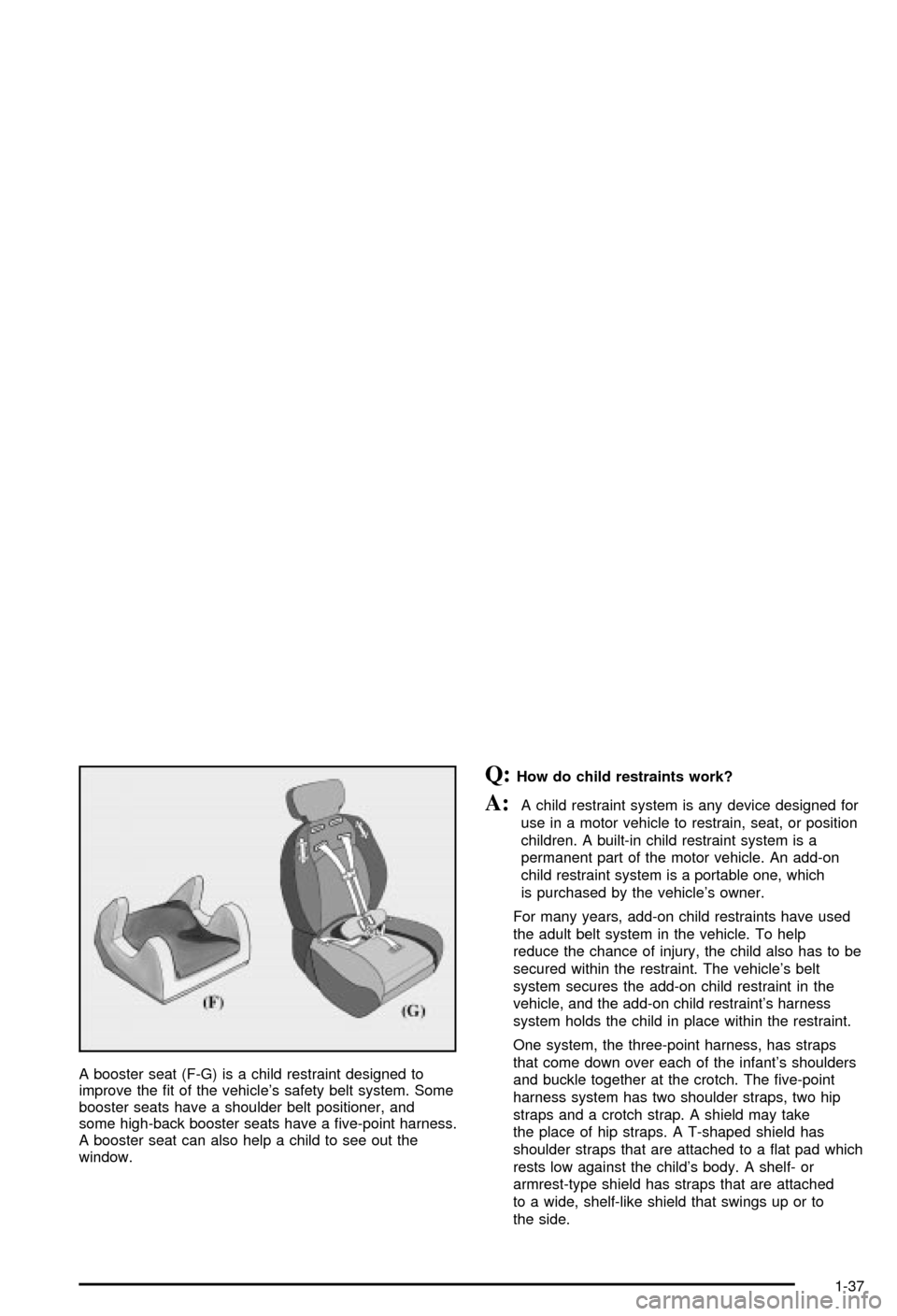
A booster seat (F-G) is a child restraint designed to
improve the ®t of the vehicle's safety belt system. Some
booster seats have a shoulder belt positioner, and
some high-back booster seats have a ®ve-point harness.
A booster seat can also help a child to see out the
window.
Q:How do child restraints work?
A:A child restraint system is any device designed for
use in a motor vehicle to restrain, seat, or position
children. A built-in child restraint system is a
permanent part of the motor vehicle. An add-on
child restraint system is a portable one, which
is purchased by the vehicle's owner.
For many years, add-on child restraints have used
the adult belt system in the vehicle. To help
reduce the chance of injury, the child also has to be
secured within the restraint. The vehicle's belt
system secures the add-on child restraint in the
vehicle, and the add-on child restraint's harness
system holds the child in place within the restraint.
One system, the three-point harness, has straps
that come down over each of the infant's shoulders
and buckle together at the crotch. The ®ve-point
harness system has two shoulder straps, two hip
straps and a crotch strap. A shield may take
the place of hip straps. A T-shaped shield has
shoulder straps that are attached to a ¯at pad which
rests low against the child's body. A shelf- or
armrest-type shield has straps that are attached
to a wide, shelf-like shield that swings up or to
the side.
1-37
Page 44 of 394
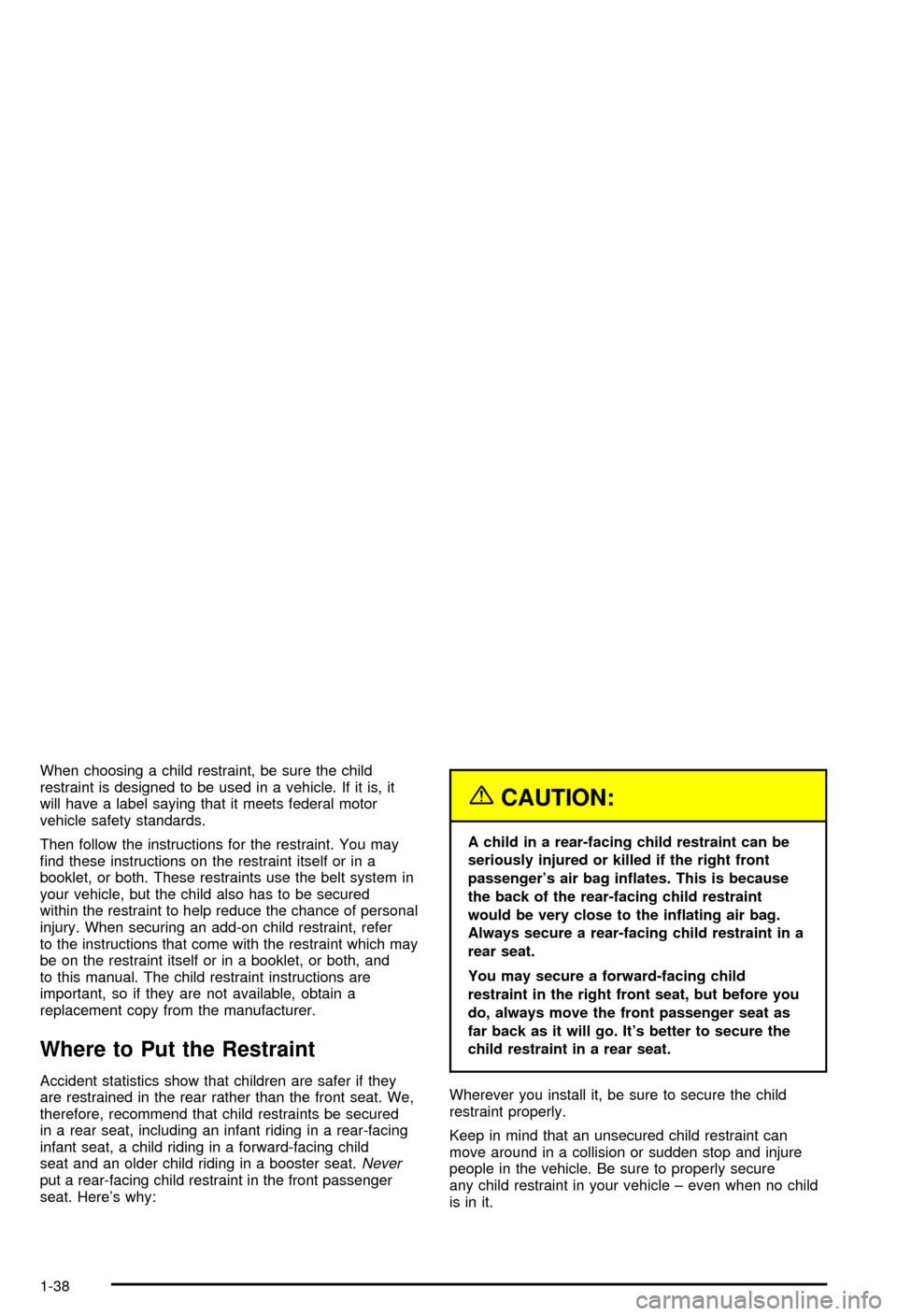
When choosing a child restraint, be sure the child
restraint is designed to be used in a vehicle. If it is, it
will have a label saying that it meets federal motor
vehicle safety standards.
Then follow the instructions for the restraint. You may
®nd these instructions on the restraint itself or in a
booklet, or both. These restraints use the belt system in
your vehicle, but the child also has to be secured
within the restraint to help reduce the chance of personal
injury. When securing an add-on child restraint, refer
to the instructions that come with the restraint which may
be on the restraint itself or in a booklet, or both, and
to this manual. The child restraint instructions are
important, so if they are not available, obtain a
replacement copy from the manufacturer.
Where to Put the Restraint
Accident statistics show that children are safer if they
are restrained in the rear rather than the front seat. We,
therefore, recommend that child restraints be secured
in a rear seat, including an infant riding in a rear-facing
infant seat, a child riding in a forward-facing child
seat and an older child riding in a booster seat.
Neverput a rear-facing child restraint in the front passenger
seat. Here's why:
{CAUTION:
A child in a rear-facing child restraint can be
seriously injured or killed if the right front
passenger's air bag in¯ates. This is because
the back of the rear-facing child restraint
would be very close to the in¯ating air bag.
Always secure a rear-facing child restraint in a
rear seat.
You may secure a forward-facing child
restraint in the right front seat, but before you
do, always move the front passenger seat as
far back as it will go. It's better to secure the
child restraint in a rear seat.
Wherever you install it, be sure to secure the child
restraint properly.
Keep in mind that an unsecured child restraint can
move around in a collision or sudden stop and injure
people in the vehicle. Be sure to properly secure
any child restraint in your vehicle ┬▒ even when no child
is in it.
1-38
Page 46 of 394
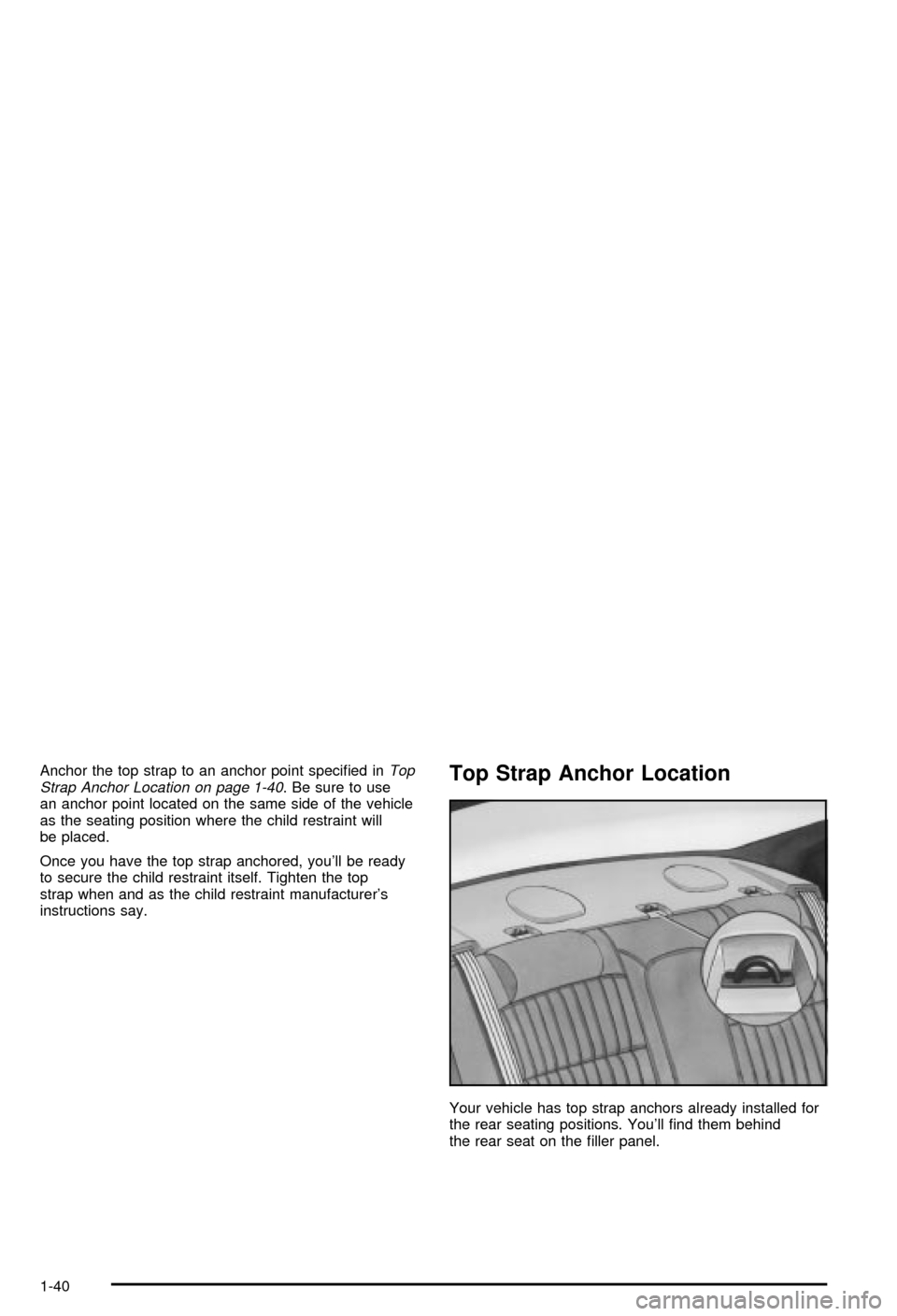
Anchor the top strap to an anchor point speci®ed inTop
Strap Anchor Location on page 1-40. Be sure to use
an anchor point located on the same side of the vehicle
as the seating position where the child restraint will
be placed.
Once you have the top strap anchored, you'll be ready
to secure the child restraint itself. Tighten the top
strap when and as the child restraint manufacturer's
instructions say.Top Strap Anchor Location
Your vehicle has top strap anchors already installed for
the rear seating positions. You'll ®nd them behind
the rear seat on the ®ller panel.
1-40
Page 47 of 394
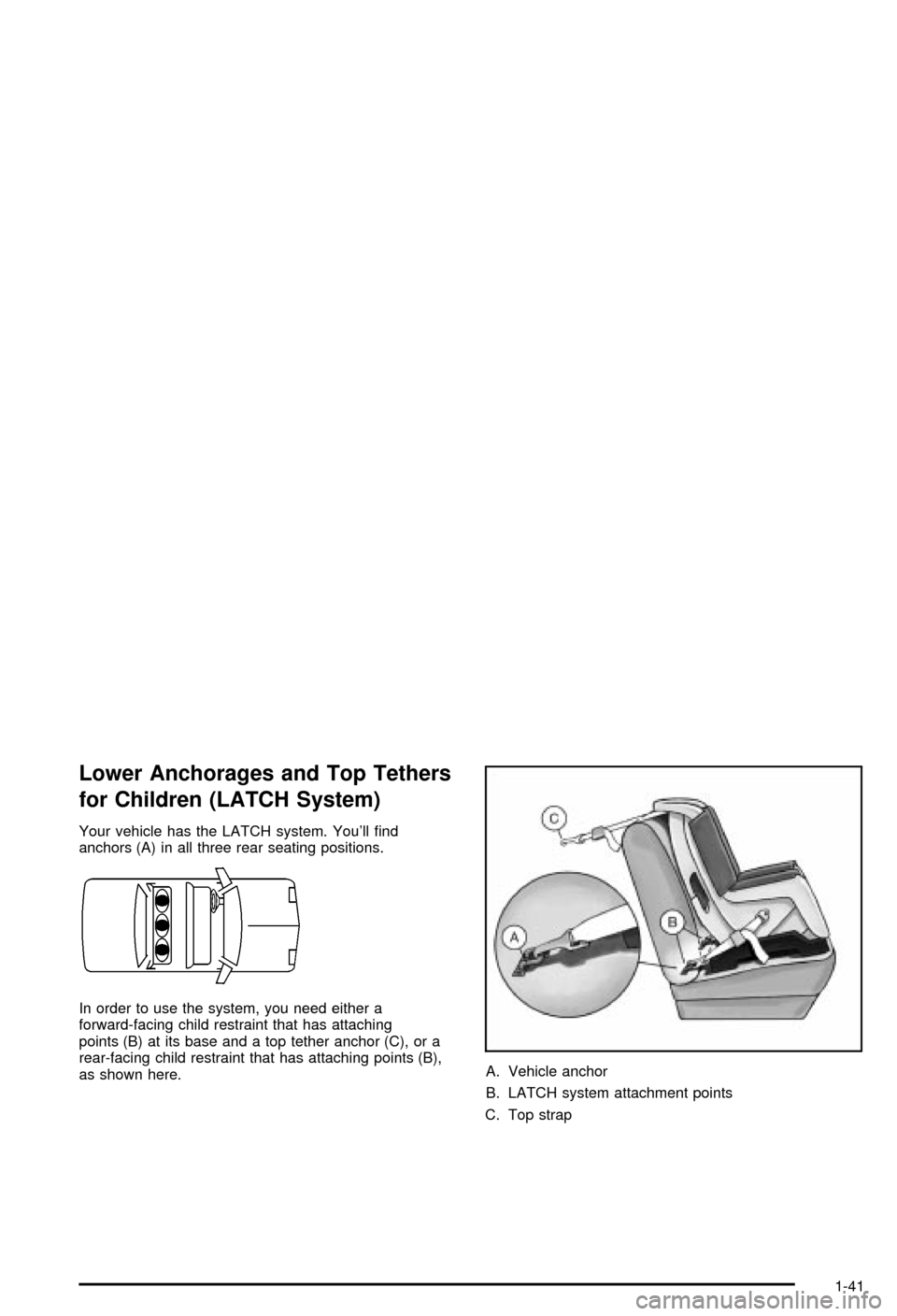
Lower Anchorages and Top Tethers
for Children (LATCH System)
Your vehicle has the LATCH system. You'll ®nd
anchors (A) in all three rear seating positions.
In order to use the system, you need either a
forward-facing child restraint that has attaching
points (B) at its base and a top tether anchor (C), or a
rear-facing child restraint that has attaching points (B),
as shown here.A. Vehicle anchor
B. LATCH system attachment points
C. Top strap
1-41
Page 48 of 394
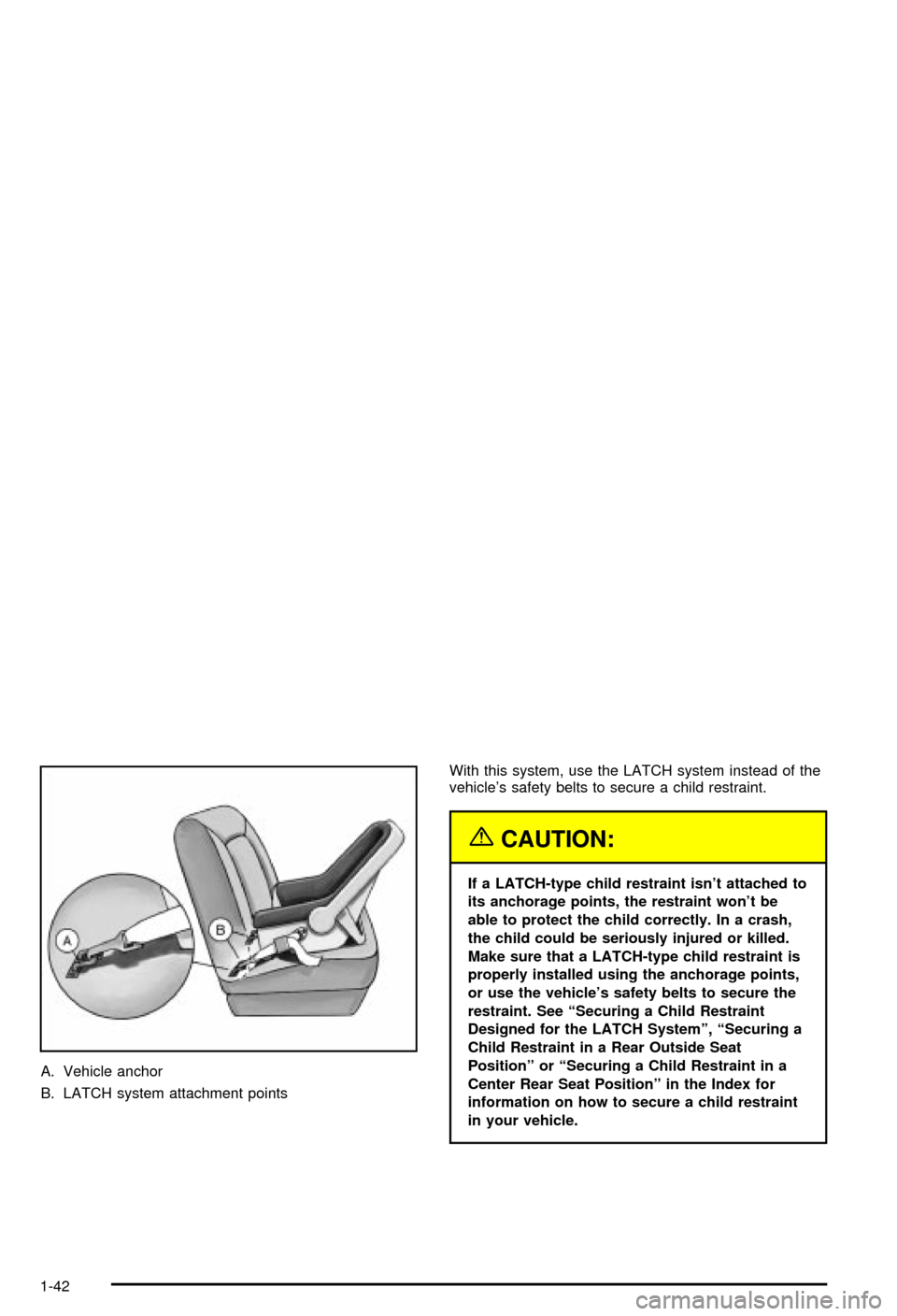
A. Vehicle anchor
B. LATCH system attachment pointsWith this system, use the LATCH system instead of the
vehicle's safety belts to secure a child restraint.
{CAUTION:
If a LATCH-type child restraint isn't attached to
its anchorage points, the restraint won't be
able to protect the child correctly. In a crash,
the child could be seriously injured or killed.
Make sure that a LATCH-type child restraint is
properly installed using the anchorage points,
or use the vehicle's safety belts to secure the
restraint. See ªSecuring a Child Restraint
Designed for the LATCH Systemº, ªSecuring a
Child Restraint in a Rear Outside Seat
Positionº or ªSecuring a Child Restraint in a
Center Rear Seat Position┬║ in the Index for
information on how to secure a child restraint
in your vehicle.
1-42
Page 49 of 394
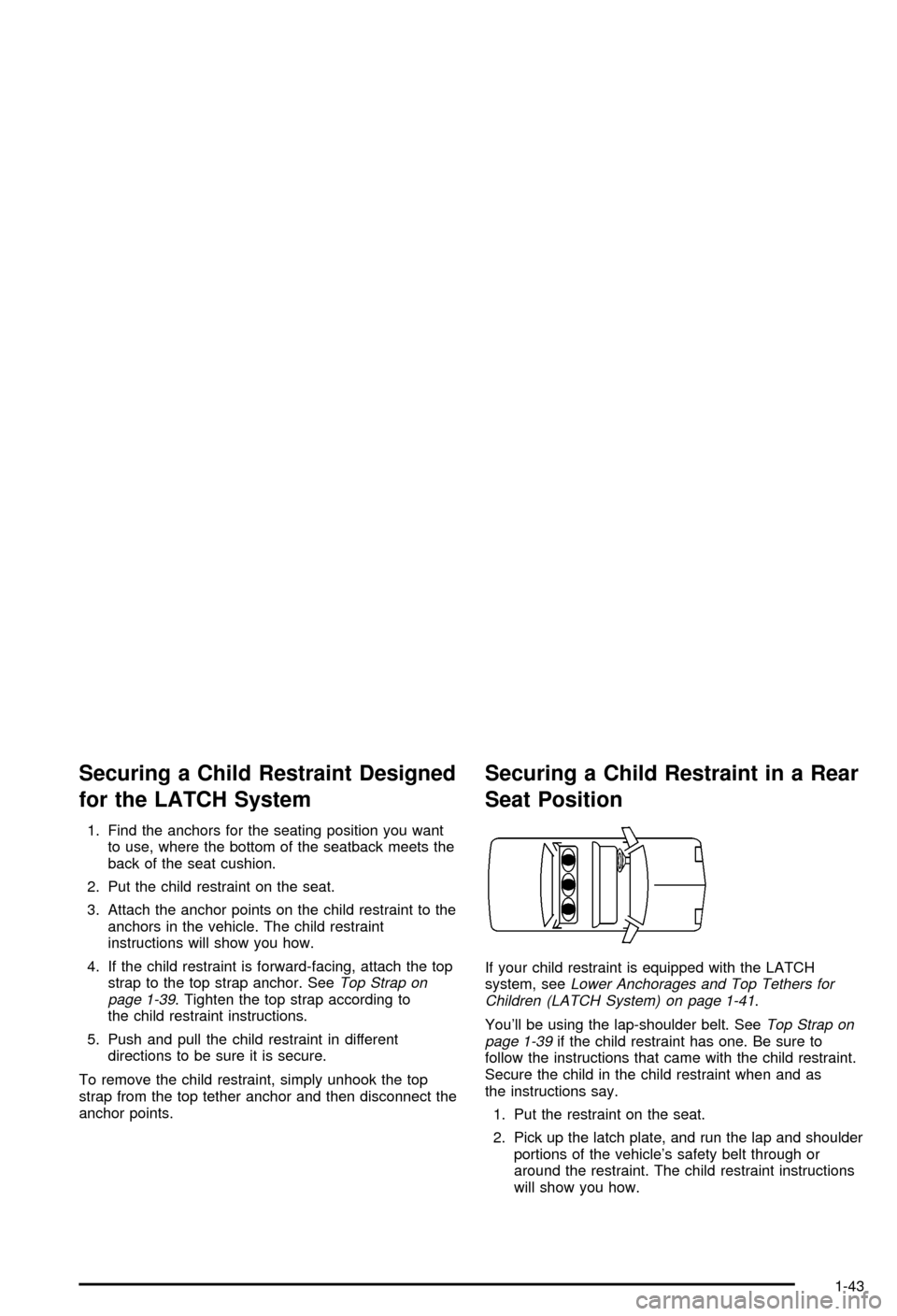
Securing a Child Restraint Designed
for the LATCH System
1. Find the anchors for the seating position you want
to use, where the bottom of the seatback meets the
back of the seat cushion.
2. Put the child restraint on the seat.
3. Attach the anchor points on the child restraint to the
anchors in the vehicle. The child restraint
instructions will show you how.
4. If the child restraint is forward-facing, attach the top
strap to the top strap anchor. See
Top Strap on
page 1-39. Tighten the top strap according to
the child restraint instructions.
5. Push and pull the child restraint in different
directions to be sure it is secure.
To remove the child restraint, simply unhook the top
strap from the top tether anchor and then disconnect the
anchor points.
Securing a Child Restraint in a Rear
Seat Position
If your child restraint is equipped with the LATCH
system, seeLower Anchorages and Top Tethers for
Children (LATCH System) on page 1-41.
You'll be using the lap-shoulder belt. See
Top Strap on
page 1-39if the child restraint has one. Be sure to
follow the instructions that came with the child restraint.
Secure the child in the child restraint when and as
the instructions say.
1. Put the restraint on the seat.
2. Pick up the latch plate, and run the lap and shoulder
portions of the vehicle's safety belt through or
around the restraint. The child restraint instructions
will show you how.
1-43
Page 52 of 394
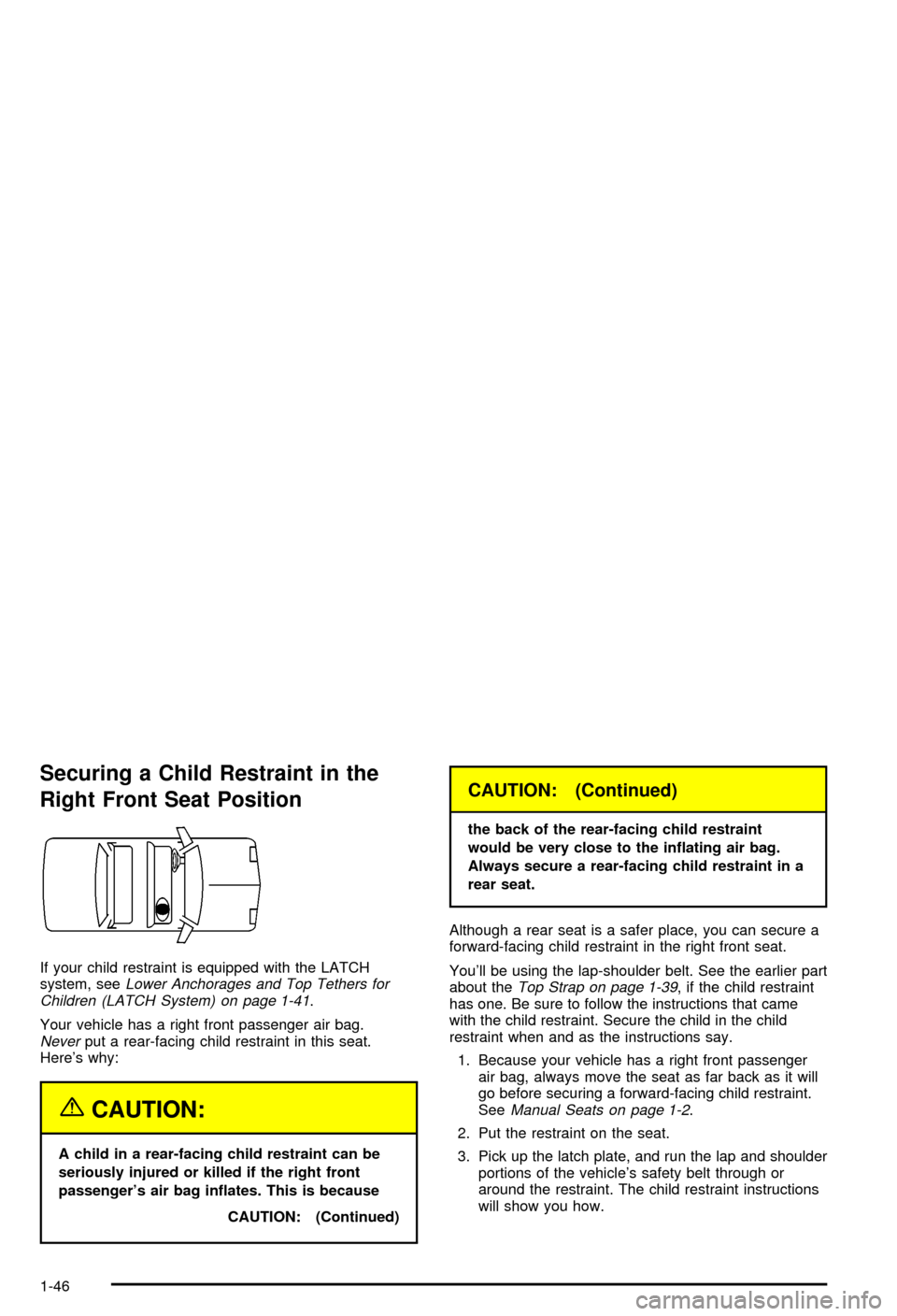
Securing a Child Restraint in the
Right Front Seat Position
If your child restraint is equipped with the LATCH
system, seeLower Anchorages and Top Tethers for
Children (LATCH System) on page 1-41.
Your vehicle has a right front passenger air bag.
Neverput a rear-facing child restraint in this seat.
Here's why:
{CAUTION:
A child in a rear-facing child restraint can be
seriously injured or killed if the right front
passenger's air bag in¯ates. This is because
CAUTION: (Continued)
CAUTION: (Continued)
the back of the rear-facing child restraint
would be very close to the in¯ating air bag.
Always secure a rear-facing child restraint in a
rear seat.
Although a rear seat is a safer place, you can secure a
forward-facing child restraint in the right front seat.
You'll be using the lap-shoulder belt. See the earlier part
about the
Top Strap on page 1-39, if the child restraint
has one. Be sure to follow the instructions that came
with the child restraint. Secure the child in the child
restraint when and as the instructions say.
1. Because your vehicle has a right front passenger
air bag, always move the seat as far back as it will
go before securing a forward-facing child restraint.
See
Manual Seats on page 1-2.
2. Put the restraint on the seat.
3. Pick up the latch plate, and run the lap and shoulder
portions of the vehicle's safety belt through or
around the restraint. The child restraint instructions
will show you how.
1-46
Page 54 of 394
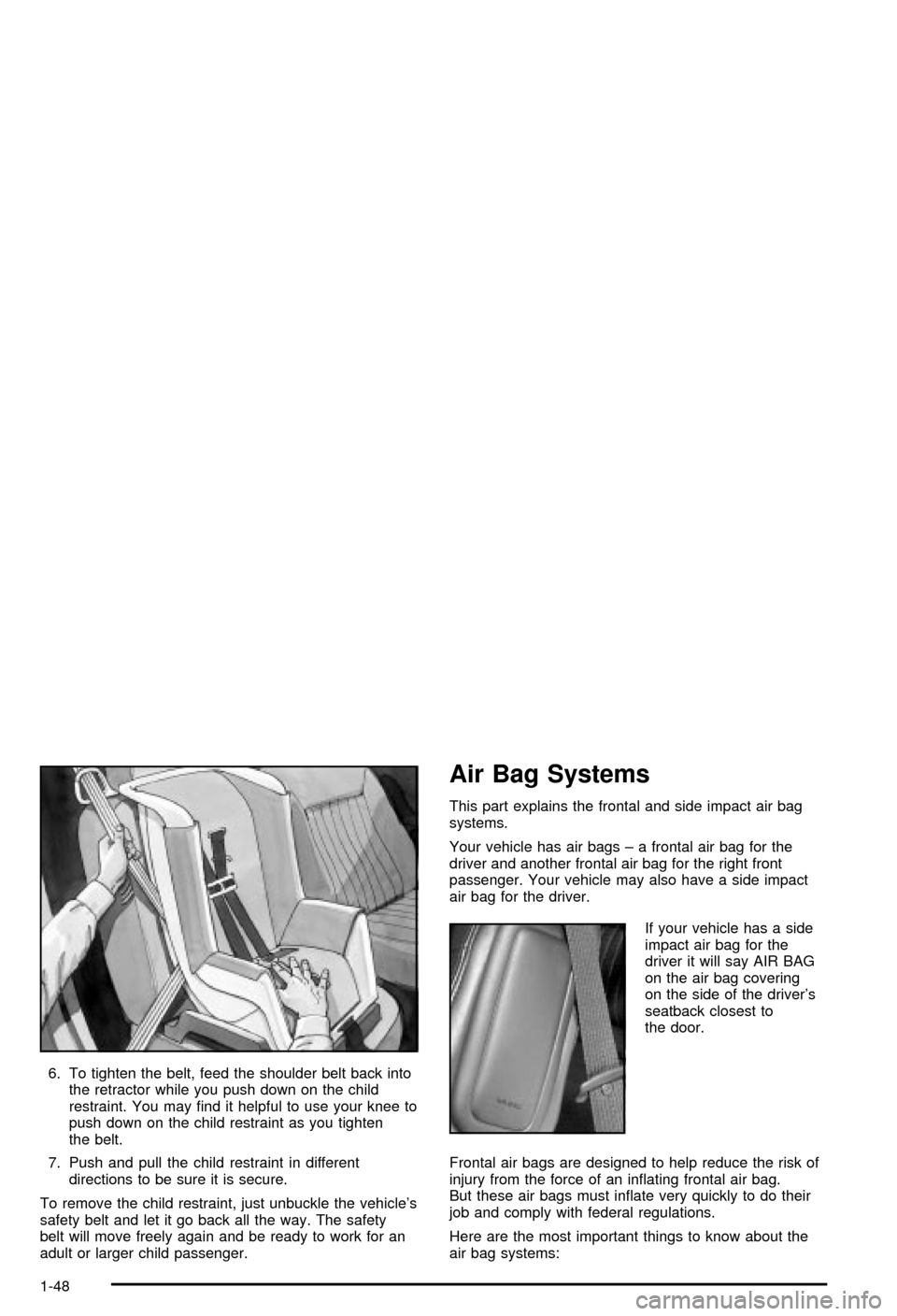
6. To tighten the belt, feed the shoulder belt back into
the retractor while you push down on the child
restraint. You may ®nd it helpful to use your knee to
push down on the child restraint as you tighten
the belt.
7. Push and pull the child restraint in different
directions to be sure it is secure.
To remove the child restraint, just unbuckle the vehicle's
safety belt and let it go back all the way. The safety
belt will move freely again and be ready to work for an
adult or larger child passenger.
Air Bag Systems
This part explains the frontal and side impact air bag
systems.
Your vehicle has air bags ┬▒ a frontal air bag for the
driver and another frontal air bag for the right front
passenger. Your vehicle may also have a side impact
air bag for the driver.
If your vehicle has a side
impact air bag for the
driver it will say AIR BAG
on the air bag covering
on the side of the driver's
seatback closest to
the door.
Frontal air bags are designed to help reduce the risk of
injury from the force of an in¯ating frontal air bag.
But these air bags must in¯ate very quickly to do their
job and comply with federal regulations.
Here are the most important things to know about the
air bag systems:
1-48
Page 241 of 394
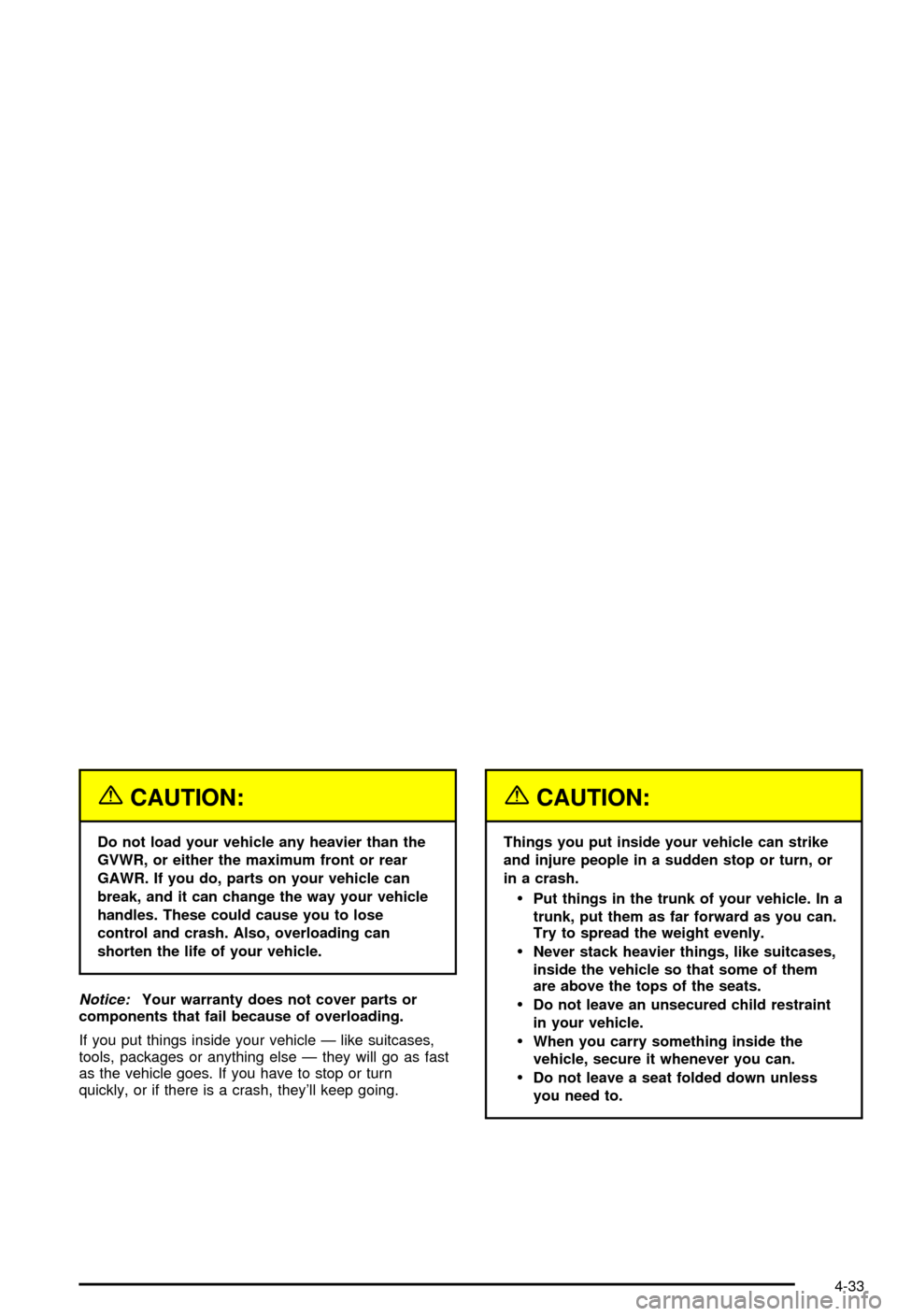
{CAUTION:
Do not load your vehicle any heavier than the
GVWR, or either the maximum front or rear
GAWR. If you do, parts on your vehicle can
break, and it can change the way your vehicle
handles. These could cause you to lose
control and crash. Also, overloading can
shorten the life of your vehicle.
Notice:Your warranty does not cover parts or
components that fail because of overloading.
If you put things inside your vehicle Ð like suitcases,
tools, packages or anything else Ð they will go as fast
as the vehicle goes. If you have to stop or turn
quickly, or if there is a crash, they'll keep going.
{CAUTION:
Things you put inside your vehicle can strike
and injure people in a sudden stop or turn, or
in a crash.
┬ĚPut things in the trunk of your vehicle. In a
trunk, put them as far forward as you can.
Try to spread the weight evenly.
┬ĚNever stack heavier things, like suitcases,
inside the vehicle so that some of them
are above the tops of the seats.
┬ĚDo not leave an unsecured child restraint
in your vehicle.
┬ĚWhen you carry something inside the
vehicle, secure it whenever you can.
┬ĚDo not leave a seat folded down unless
you need to.
4-33
Page 381 of 394
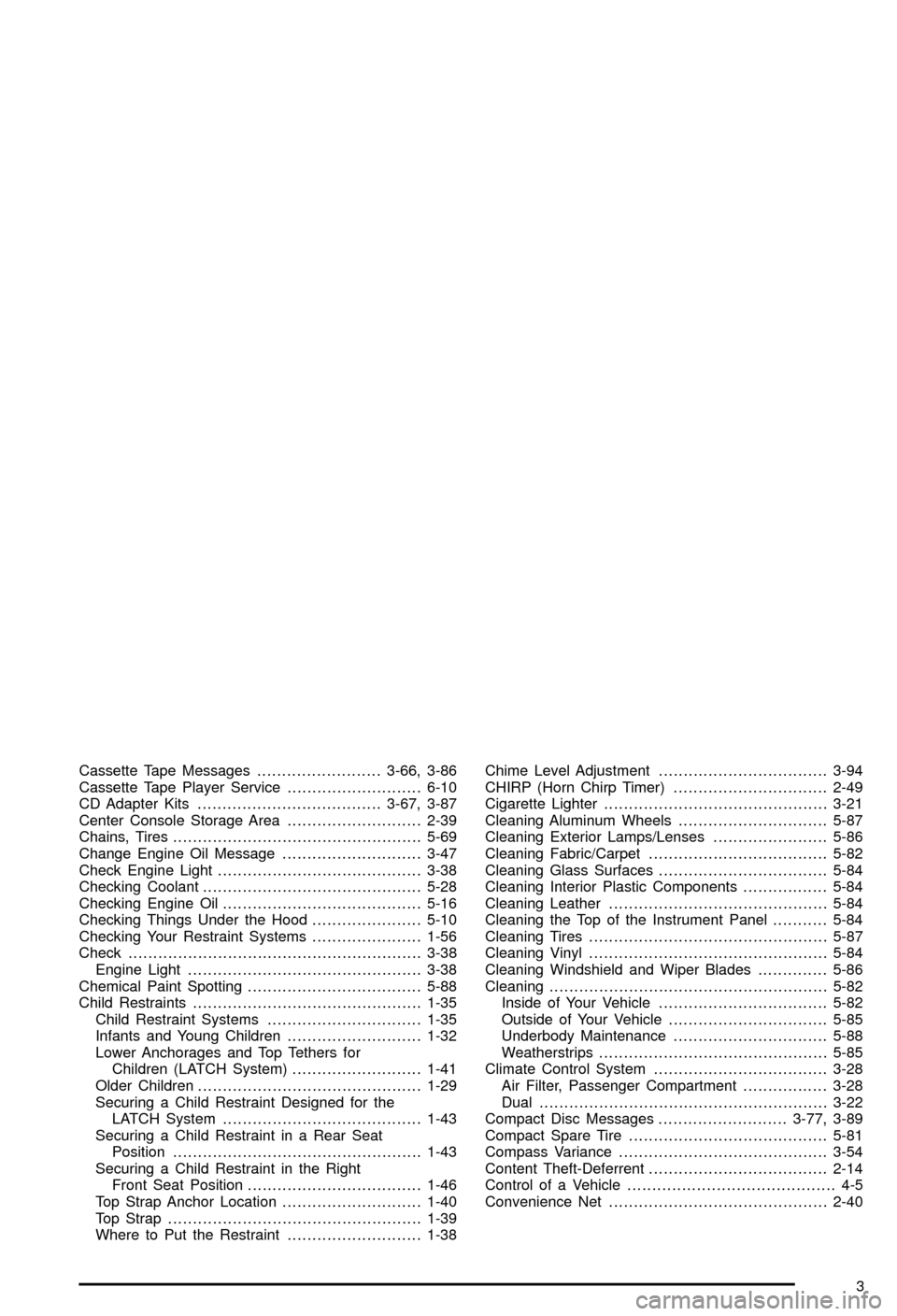
Cassette Tape Messages.........................3-66, 3-86
Cassette Tape Player Service...........................6-10
CD Adapter Kits.....................................3-67, 3-87
Center Console Storage Area...........................2-39
Chains, Tires..................................................5-69
Change Engine Oil Message............................3-47
Check Engine Light.........................................3-38
Checking Coolant............................................5-28
Checking Engine Oil........................................5-16
Checking Things Under the Hood......................5-10
Checking Your Restraint Systems......................1-56
Check...........................................................3-38
Engine Light...............................................3-38
Chemical Paint Spotting...................................5-88
Child Restraints..............................................1-35
Child Restraint Systems...............................1-35
Infants and Young Children...........................1-32
Lower Anchorages and Top Tethers for
Children (LATCH System)..........................1-41
Older Children.............................................1-29
Securing a Child Restraint Designed for the
LATCH System........................................1-43
Securing a Child Restraint in a Rear Seat
Position..................................................1-43
Securing a Child Restraint in the Right
Front Seat Position...................................1-46
Top Strap Anchor Location............................1-40
Top Strap...................................................1-39
Where to Put the Restraint...........................1-38Chime Level Adjustment..................................3-94
CHIRP (Horn Chirp Timer)...............................2-49
Cigarette Lighter.............................................3-21
Cleaning Aluminum Wheels..............................5-87
Cleaning Exterior Lamps/Lenses.......................5-86
Cleaning Fabric/Carpet....................................5-82
Cleaning Glass Surfaces..................................5-84
Cleaning Interior Plastic Components.................5-84
Cleaning Leather............................................5-84
Cleaning the Top of the Instrument Panel...........5-84
Cleaning Tires................................................5-87
Cleaning Vinyl................................................5-84
Cleaning Windshield and Wiper Blades..............5-86
Cleaning........................................................5-82
Inside of Your Vehicle..................................5-82
Outside of Your Vehicle................................5-85
Underbody Maintenance...............................5-88
Weatherstrips..............................................5-85
Climate Control System...................................3-28
Air Filter, Passenger Compartment.................3-28
Dual..........................................................3-22
Compact Disc Messages..........................3-77, 3-89
Compact Spare Tire........................................5-81
Compass Variance..........................................3-54
Content Theft-Deferrent....................................2-14
Control of a Vehicle.......................................... 4-5
Convenience Net............................................2-40
3